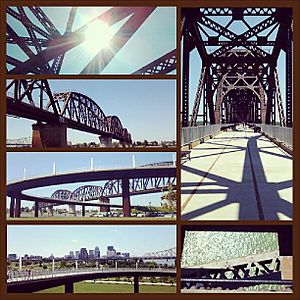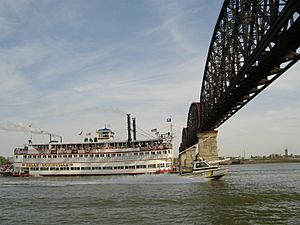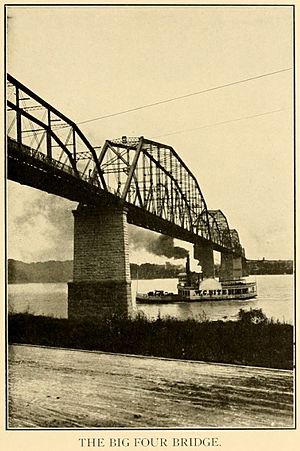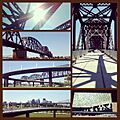Big Four Bridge facts for kids
Quick facts for kids Big Four Bridge |
|
|---|---|

The Big Four Bridge from various angles in May 2013
|
|
| Coordinates | 38°15′56″N 85°44′20″W / 38.26556°N 85.73889°W |
| Carries | Pedestrians and cyclists |
| Crosses | Ohio River |
| Locale | Louisville, Kentucky, and Jeffersonville, Indiana, United States |
| Characteristics | |
| Total length | 2,525 ft (770 m) |
| Longest span | 547 ft (167 m) |
| Clearance above | 53 ft (16 m) |
| History | |
| Construction cost | $3.5 million |
| Opened | 1895 |
| Closed | End of railroad use 1968 |
The Big Four Bridge is a famous truss bridge that crosses the Ohio River. It connects Louisville, Kentucky, and Jeffersonville, Indiana. This bridge was first built for trains. It opened in 1895 and was updated in 1929.
Trains stopped using the bridge in 1968. Later, it was changed into a path for people walking and riding bikes. This new path opened in 2014. The longest single section of the bridge is 547 feet (167 m). The whole bridge is 2,525 feet (770 m) long. It got its name from the "Big Four Railroad," which was a nickname for the Cleveland, Cincinnati, Chicago and St. Louis Railway.
Today, only people walking or biking can use the Big Four Bridge. A special ramp for people in Kentucky opened on February 7, 2013. The original ramps that trains used were removed in the 1970s. This made the Big Four Bridge famous as the "Bridge That Goes Nowhere." Before this bridge opened for walkers and bikers, the George Rogers Clark Memorial Bridge was the only way to cross the river by foot or bike.
In 2011, Kentucky and Indiana decided to fund the project to finish the bridge. They wanted to create a path for walkers and bikers. Indiana spent money to build a ramp in Jeffersonville. Kentucky paid to fix the bridge deck and connect it to a spiral ramp in Waterfront Park. The Jeffersonville ramp opened on May 20, 2014.
Contents
About the Big Four Bridge
The Big Four Bridge has six main sections. It is 2,525 ft (770 m) long. It also has a clearance of 53 ft (16 m) above the river. This means boats can pass safely underneath. The bridge was designed to carry a single train track.
The northernmost section is a special type of riveted bridge called an 8-panel Parker through truss. The next three sections are 547 ft (167 m) long. They are riveted, 16-panel Pennsylvania through trusses. The two southern sections are riveted, 10-panel Parker through trusses.
Building the Big Four Bridge
People in Jeffersonville first thought about building the Big Four Bridge in 1885. A company called the Louisville and Jeffersonville Bridge Company was formed in 1887. They planned to build the bridge. The United States Army Corps of Engineers approved the building site. This was even though some people who worked with riverboats wanted it built somewhere else.
Construction Challenges
Building the Big Four Bridge began on October 10, 1888. It was a very difficult project. Many workers faced serious accidents during its construction. On January 9, 1890, a caisson (a watertight box used for underwater work) flooded. This caused several workers to drown. A few months later, on May 14, 1890, a wooden beam broke. This led to more accidents.
One of the biggest accidents happened on December 15, 1893. A strong wind blew a construction crane. This damaged the supports for a bridge section. Forty-one workers were on that section when it fell into the Ohio River. Twenty-one workers died. Another section of the bridge also fell later, but no one was on it. After these events, builders made the bridge supports stronger. They also added special bracing to prevent wind damage. A new safety rule was also put in place: always replace temporary bolted joints with permanent riveted ones as soon as possible.

The Big Four Bridge was finally finished in September 1895. Because of the high costs from the accidents, the building company sold the bridge. It was bought by the Cleveland, Cincinnati, Chicago and St. Louis Railway. This railway was also known as the Big Four Railroad. This purchase gave the railway its first direct access to Louisville.
The Bridge as a Railway
When the Big Four Bridge opened, it changed how goods were moved. More freight was carried by trains. This meant fewer packet boats crossed the Ohio River.
On February 19, 1904, a Baltimore and Ohio train accidentally crossed the bridge. The engineer fell asleep and went the wrong way. The conductor finally noticed the mistake. The train had to back up all the way.
The first interurban (a type of electric train) crossed the bridge on September 12, 1905. On January 14, 1918, two interurban trains crashed on the bridge. This happened during a snowstorm. Three passengers died, and many were injured.
Bridge Upgrades
Trains became heavier over time. So, in June 1928, plans were made to build a stronger Big Four Bridge. The new bridge opened on June 25, 1929. It was built on the same piers as the old bridge. This was a clever way to build it faster. The old bridge helped support the new one during construction. While the bridge was being rebuilt, trains used the Kentucky & Indiana Terminal Bridge. Interurban passengers had to take buses into Louisville.
Nearby Highway Bridge
In 1961, the John F. Kennedy Memorial Bridge was built for I-65. It crosses the Ohio River near the Big Four Bridge. Because of where the Big Four Bridge was, the highway interchange had to be built around its supports. This created many ramps and earned the nickname Spaghetti Junction.
Who Owned the Bridge?
In 1988, Oscar Arias, who was the President of Costa Rica, asked about buying the bridge. He thought it would be cheaper to move the bridge to Costa Rica than build a new one. However, the city did not own the bridge at that time, so the plan never happened.
After the Trains Stopped
The Big Four Bridge stopped being used by trains in 1968. This happened after the Big Four Railroad's parent company merged with another company. The last train crossed the bridge on March 10, 1968. Train traffic was then moved to Louisville's Fourteenth Street Bridge.
From 1974 to 1975, both of the bridge's approach spans were removed. They were sold for scrap metal. This is why the Big Four Bridge became known as the "Bridge That Goes Nowhere." It was the first bridge in Louisville to stop being used.
During the 1970s and 1980s, a local radio station, WLRS-102 FM, decorated the bridge with lights. This was part of their "Bridge the Gap" Christmas event. It helped raise money for families in need. Some of the lights even spelled out "LRS 102."
Becoming a Pedestrian Bridge
People had wanted to turn the Big Four Bridge into a path for walkers and bikers since the 1990s. This project was part of improving the Louisville Waterfront Park and the riverfront area.
In February 2013, people could finally walk onto the bridge from the Kentucky side ramp. The Indiana ramp opened on May 20, 2014. Lights were added along the bridge for safety. The lighting was designed to be beautiful and to please nearby residents. The Kentucky side has computer-controlled lights that can show many colors.
During Thunder Over Louisville, a big fireworks show, the Big Four Bridge marks a boundary. Private boats cannot get closer to the fireworks than this bridge.
The Waterfront Development Corporation spent money to improve the Louisville Waterfront Park near the bridge. These upgrades happened from late 2015 to early 2016. They added more plants, a new path, and a plaza under the bridge.
Bridge Fires
Between the time it stopped being a train bridge and became a pedestrian bridge, the Big Four Bridge had a few fires. There were two in the 1970s, one in 1987, and one in 2008. The 1987 fire started from Christmas lights that were put up for a toy drive. Firefighters from both Jeffersonville and Louisville worked for hours to put out the blaze.
On May 7, 2008, another fire started on the bridge. It was about a quarter-mile (400 m) from the Louisville end. The fire was about 70 to 80 ft (21 to 24 m) above the Ohio River. It was thought to have started from an electrical problem. This fire was especially difficult because the bridge was old. The wooden parts were not safe for firefighters to climb.
Louisville Fire & Rescue chief Greg Frederick decided not to send firefighters onto the bridge. Instead, a boat from the Harrods Creek Fire Department was used to spray water on the fire. The Coast Guard stopped river traffic around the bridge because debris was falling. It took two and a half hours to control the fire.
Images for kids
-
The Belle of Louisville passing under the bridge in 2008











